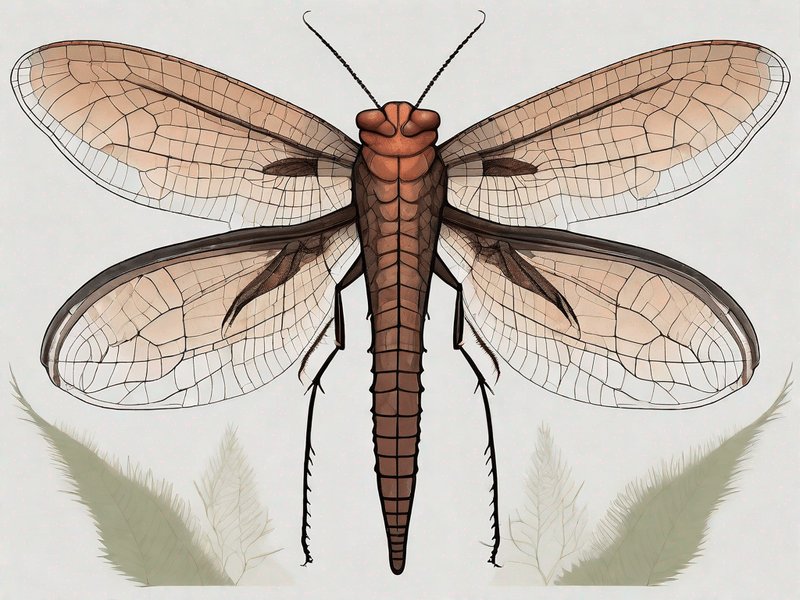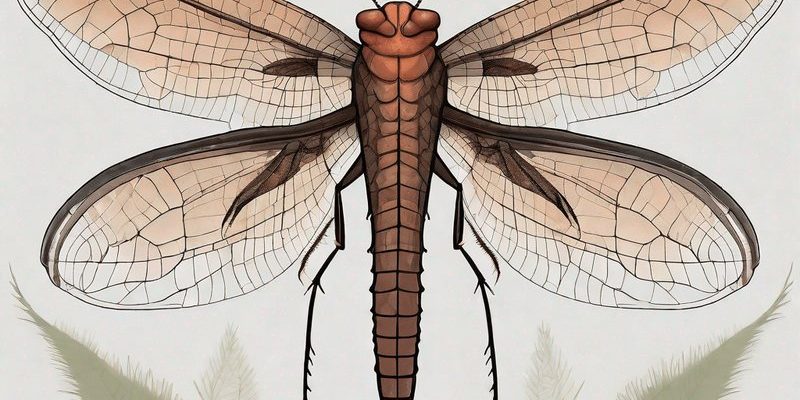
Picture a warm summer evening. As the sun dips below the horizon, you might hear the whirring of wings and the soft rustle of leaves. Among the many creatures stirring to life is the dobsonfly, an insect that captures the imagination with its unique appearance and fascinating behaviors. With their large size and striking features, these nocturnal insects can easily catch your eye, but there’s so much more to them than meets the eye.
The dobsonfly is often mistaken for a dragonfly due to its similar build, but these two insects are different in many ways. They belong to the order Neuroptera and are known for their impressive wingspan and peculiar life cycle. If you’ve ever seen one, you might have wondered about its lifestyle, habitat, and even its role in the ecosystem. Let’s dive into the world of dobsonflies and explore what makes them so fascinating!
Physical Characteristics
Dobsonflies are definitely not your run-of-the-mill insects. They are large, with adults often measuring between 3 to 5 inches in length. Their wings can span even wider, creating an impressive visual display. These insects are typically brown or gray, helping them blend into their surroundings. What really sets them apart are the long, elongated mandibles of the males, which resemble pincers. These mandibles are not just for show; they play a significant role in mating rituals as well as in defending themselves against predators.
The body of a dobsonfly is elongated and somewhat flat, with a pair of large, transparent wings that are intricately veined. When they rest, these wings fold over their body, adding to their camouflage. You might also notice their distinctive antennae, which are long and feathery, enhancing their sensitivity to the environment. This heightened sense allows them to detect pheromones and other signals that guide their behavior, whether they’re seeking mates or avoiding threats.
Life Cycle and Reproduction
Diving into the life cycle of dobsonflies is like unfolding a complex story. They undergo a complete metamorphosis, which means they go through several stages: egg, larva, pupa, and adult. The female lays her eggs in or near water, making streams or ponds the perfect home for their young. This is crucial because the larvae, known as hellgrammites, are aquatic and live in the water for up to three years before they emerge as adults.
Once hatched, the hellgrammites feed on aquatic insects and small animals, growing quickly in their underwater habitat. They are fierce predators themselves, showcasing a robust feeding strategy that helps them thrive. After maturing, they crawl out of the water and burrow into the soil to pupate. This stage can last several weeks, during which the transformation into the adult dobsonfly occurs.
When they finally emerge, it’s a matter of days before males can be seen flying around, searching for females. Mating typically happens shortly after emergence, and females will lay eggs within just a few days. This rapid cycle ensures that the population can thrive and adapt to their environment efficiently.
Habitat and Distribution
Dobsonflies are primarily found in North America, with a preference for areas near clean, flowing water. They are usually spotted in streams, rivers, and even lakes. Their habitats are crucial to their survival, as they rely on aquatic environments for their larvae. The presence of dobsonflies can often indicate a healthy ecosystem, as they require clean water to thrive, making them somewhat of an environmental barometer.
In terms of geographical distribution, dobsonflies have been documented in various regions, from the east coast to the west. While they need specific conditions for their larvae, adults can often be seen flying around gardens and yards, especially during warm nights in the summer months. Their flight is typically clumsy yet powerful, allowing them to navigate between trees and other vegetation.
Diet and Feeding Habits
The diet of a dobsonfly differs significantly between life stages. As adults, they primarily feed on nectar from flowers, although they don’t consume food as frequently as other insects. Their main purpose as adults is to reproduce and lay eggs, which means they occupy a limited feeding role compared to their larvae. However, their mandibles are certainly capable of delivering a painful bite, though they rarely use them against humans.
On the other hand, hellgrammites are voracious predators. These predatory larvae feast on a diet of smaller aquatic creatures, including insects and even small fish. Their natural strategy is to ambush prey, displaying a surprising level of aggression. This predatory behavior allows them to grow quickly and transition into their adult stage efficiently.
Behavior and Adaptations
The behavior of dobsonflies is fascinating, especially when you consider their adaptations to survive in their environments. During the day, adults usually rest on vegetation, camouflaged against predators. They are nocturnal, which means they are most active at night. This timing helps them avoid daytime predators and take advantage of the cooler temperatures.
When it comes to reproduction, male dobsonflies use their large mandibles to impress females. They engage in elaborate courtship displays, which may include flying around females and showing off their impressive jaws. This behavior is crucial for attracting a mate and ensuring the continuation of their species.
Conservation Status
While dobsonflies are not currently endangered, their populations can be affected by environmental changes. Pollution and habitat destruction pose significant threats to their habitats. Because dobsonfly larvae require clean water to thrive, any degradation of freshwater ecosystems can lead to declines in their numbers. Conservation efforts aimed at preserving these habitats are essential not only for dobsonflies but for the entire aquatic ecosystem.
Being aware of the importance of clean waterways is crucial. By taking steps to reduce pollution and protect natural habitats, we can help ensure that dobsonflies and many other species can continue to thrive in our environment.
Interesting Facts about Dobsonflies
| Scientific Name | Chauliodes spp. |
| Size | 3 to 5 inches (wingspan can be broader) |
| Lifespan | 1 year (larvae may live 2-3 years) |
| Diet (Adults) | Nectar from flowers |
| Diet (Larvae) | Aquatic insects and small fish |
| Habitat | Freshwater streams and rivers |
| Distribution | North America, particularly in the East and West |
In conclusion, the dobsonfly is a remarkable insect that plays a significant role in its ecosystem. From its unique physical appearance to its interesting life cycle, these creatures are more than just another type of bug. Whether you encounter a dobsonfly flying overhead on a summer night or see its larvae skimming along the surface of a stream, remember that they are a vital part of our natural world. Protecting their habitats ensures we keep experiencing the wonder they bring to our environment.
FAQ
What do dobsonflies look like?
Dobsonflies are large insects characterized by their impressive wingspan and elongated bodies. They typically display shades of brown or gray, which helps them blend into their environments. Males have distinctive long mandibles that resemble pincers, while females have shorter ones. Their wings are transparent, with intricate veining patterns that add to their striking appearance.
Where can I find dobsonflies?
You can usually find dobsonflies near clean, flowing water, as their larvae require aquatic habitats to grow. Look for them in streams, rivers, and lakes, especially during warm summer nights when they are most active. Adults are often spotted flying around gardens or illuminated areas, drawn to light sources.
Are dobsonflies harmful to humans?
Generally, dobsonflies are not harmful to humans. Although they can bite with their large mandibles, they usually do not attack unless provoked. Their primary focus is reproduction and feeding on nectar, making them minimally invasive. However, their larvae, the hellgrammites, can deliver a painful bite if handled carelessly.
What do dobsonflies eat?
As adults, dobsonflies primarily feed on nectar from flowers. They do not consume large amounts of food and focus on reproduction. In contrast, as larvae, hellgrammites are aggressive predators that feed on smaller aquatic creatures, including insects and even tiny fish, helping them grow rapidly in their freshwater habitats.
How long do dobsonflies live?
The lifespan of a dobsonfly can vary. Adults typically live for about one year, while their larvae, known as hellgrammites, can live for up to three years in aquatic environments before emerging as adults. This extended larval stage allows them to grow and gather energy for their transformation into fully grown dobsonflies.
What is the role of dobsonflies in the ecosystem?
Dobsonflies play a significant role in their ecosystem as both predators and prey. Their larvae help control aquatic populations by preying on smaller insects and fish. They also serve as an important food source for birds and other wildlife. Healthy dobsonfly populations can indicate clean water and a balanced ecosystem, making them vital for environmental monitoring.
Can dobsonflies be used in fishing bait?
Yes! The larvae, known as hellgrammites, are popular among anglers as fishing bait due to their natural attraction to fish. They are especially effective for catching species like bass and trout. Many local bait shops sell hellgrammites, and you might even find fishermen collecting them as they know the benefit they provide in attracting larger catches.
What threats do dobsonflies face?
Dobsonflies face several threats, primarily due to habitat degradation and pollution. Because their larvae depend on clean water, any deterioration of freshwater ecosystems can significantly impact their populations. Conservation efforts focusing on protecting these habitats are crucial for ensuring the survival of dobsonflies and maintaining healthy aquatic ecosystems.
Are dobsonflies nocturnal?
Yes, dobsonflies are primarily nocturnal insects. They are most active at night, which allows them to avoid many daytime predators. Their nighttime activity coincides with their mating behaviors, as males fly around to attract females under the cloak of darkness. This behavior increases their chances of successful reproduction while minimizing risk.
Do dobsonflies sting?
Dobsonflies do not sting, but they can bite. Their large mandibles are designed more for defense and mating displays than for attacking humans. While a bite can be painful, it is usually not serious or harmful. If you encounter a dobsonfly, it’s best to observe from a distance to avoid provoking it.
How can I help protect dobsonflies and their habitats?
Protecting dobsonflies starts with being mindful of freshwater ecosystems. Avoid polluting local streams and rivers, and consider participating in or donating to local conservation efforts focused on maintaining clean waterways. Additionally, planting native plants along water bodies can provide essential habitats for dobsonflies and other wildlife, supporting the health of their ecosystems.

